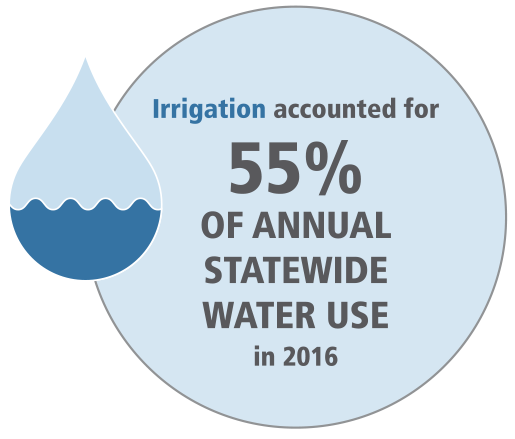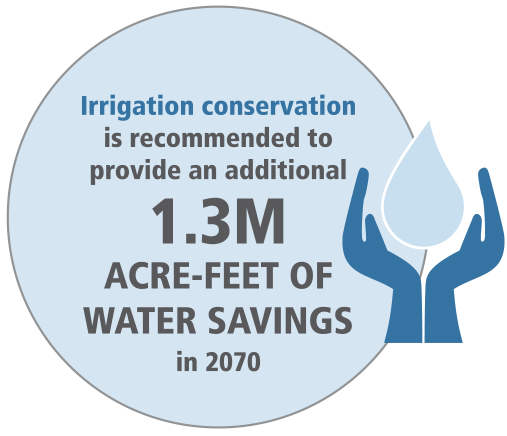
Part I
Conserving Irrigation Water to Sustain the Future of Agriculture in Texas
Irrigation for agricultural production is currently the largest water demand sector in the state, according to the 2017 State Water Plan. Growing food, feed, and fiber in Texas is a tall order that currently requires more water than quenching the thirst of our cities, powering manufacturing, and generating energy in Texas combined. This presents an incredible challenge, and one that regional water planning groups have addressed in part by recommending irrigation conservation strategies.
The 2017 State Water Plan also reports that Texas will need an additional 8.9 million acre-feet of water supplies by 2070, with irrigation accounting for 3.6 million acre-feet of those water needs. In acknowledgement of this potential shortage, regional planning groups recommended a range of strategies which, if implemented, would provide 8.5 million acre-feet of new water supplies, at a cumulative capital cost of $63 billion. Of those new supplies, irrigation conservation is recommended to provide 1.3 million acre-feet. Implementing the irrigation conservation strategies in the plan will generate significant conservation savings, yet cost less than $1.3 billion, or about 2 percent of the total capital costs of all the recommended strategies water supply projects. Furthermore, irrigation conservation is the primary strategy recommended to address the identified irrigation needs in most regions. Irrigation conservation is also the least expensive strategy type, with a statewide average implementation cost of only $147 per acre-foot in 2070.


Implementing irrigation conservation strategies and ensuring the continued viability of Texas agriculture is precisely the goal of the Agricultural Water Conservation Grants Program. Over the past 10 years, the program has provided $12.7 million in 74 funding commitments to political subdivisions and state agencies to support the implementation of irrigation conservation strategies in the state and regional water plans. Funding activities include equipment cost-share, irrigation system improvements, research, education, and demonstrations. Collectively, grant recipients reported more than 496,000 acre-feet of water savings over that same 10-year span. This equates to approximately $26 spent for every acre-foot of water saved, an efficient and effective investment in the future of Texas agriculture.

In the next installment, we’ll explore the ways these grant dollars go further and work even harder, by making possible the use of federal funds.
For more information about the program and current funding opportunities, contact AgConservation@twdb.texas.
Part II
Leveraging State and Local Match to Help with the Heavy Lift of Securing Access to Federal Funding
How do some funds unlock access to others? It often begins with a common grant requirement: local match. Local match refers to the cash or in-kind services that an entity is required to provide to become eligible for grant funds. This requirement generally encourages greater engagement by all parties—everyone has something to lose, but more importantly, everyone has more to gain by successfully implementing the project. Grant applicants put up their own funds as local match for Texas Water Development Board (TWDB) funds, and in turn may also use TWDB-awarded funds as required state and local match toward larger federal grant opportunities.
Over the past 10 years, the TWDB and a handful of Agricultural Water Conservation Grants Program recipients have used the funds to do just that. Tapping into federal grant pools has leveraged millions in additional federal funds to support and implement irrigation conservation across the state, significantly and strategically amplifying TWDB’s grant awards.
Let’s look at a few examples:
- In 2009, the TWDB leveraged the success of the Texas Alliance for Water Conservation project, the voluntary irrigation metering program, and other grant projects in an Agricultural Water Enhancement Program application, funded by the U.S. Department of Agriculture – Natural Resources Conservation Service (NRCS). The TWDB served as the project sponsor, with assistance and support from 10 of the confirmed groundwater conservation districts in the 49-county Texas High Plains Ogallala Aquifer region. This resulted in agricultural producers receiving access to an additional $22 million in cost-share assistance for irrigation conservation practices and system improvements through the Texas Agriculture Water Conservation Enhancement Program-Ogallala Aquifer.
- The Texas Water Resources Institute, Texas A&M AgriLife, and the Texas State Soil & Water Conservation Board leveraged TWDB grant funding and other funding sources to support a $4.3 million grant for the Lower Rio Grande Valley Water Improvement Initiative, funded in 2014 and 2015, through the USDA-NRCS Regional Conservation Partnership Program. The project promotes agricultural water conservation practices to address water quality and water quantity concerns in the region.
- In 2016, the High Plains Water District and several other groundwater conservation districts overlying the Ogallala Aquifer applied for funding through the USDA-NRCS Regional Conservation Partnership Program. The districts leveraged existing TWDB demonstration and equipment cost-share grant projects to successfully secure access to an additional $2 million for agricultural producers’ conservation practices through a project called the Limited Applied Irrigation Assistance Program.
- A number of irrigation districts and other water providers throughout the state have successfully secured funding from both the TWDB and the U.S. Bureau of Reclamation to complete costly infrastructure improvements. Recent examples include the Saldaña Pipeline Project in Cameron County Irrigation District #6, the McLeod-Hood Reservoir in the Harlingen Irrigation District, and the Lower Colorado River Authority’s Gulf Coast Irrigation Division Gate Rehabilitation Project.
While the specificity of the TWDB grants allows the program to directly serve local interests, partnering with federal programs enables adjacent entities to work collaboratively across a region, aquifer, or basin. In many cases, waterways transcend political boundaries, and it makes sense for funding to be optimized similarly. TWDB funds provide the means required to unlock larger-scale approaches, enabling stakeholders to address water conservation needs more broadly and, in many cases, more appropriately.
Next up, we’ll highlight a few of the Agricultural Water Conservation Grant Program's standout projects. These projects have garnered statewide, national, and even some international attention for their ingenuity and impact and are examples of just how hard and how smart those local, state, and federal dollars can work together to address critical conservation issues.
Part III
Proven Success & an Award-Winning Track Record
Recognition has a way of galvanizing folks around a common vision and encouraging them to keep pursuing both difficult and meaningful goals. That’s why we’re delighted that several of our Agricultural Water Conservation Grant recipients have spent some time in the spotlight. Although we’re big fans of all our projects, several of them have won state, national, and even international recognition over the years, signaling the relevance of informed solutions to critical conservation issues.
In 2005 and 2014, the Texas Water Development Board (TWDB) provided funding to Texas Tech University and its project partners for the Texas Alliance for Water Conservation (TAWC) project. The project brings together academia, agricultural producers, industry, and government to collaboratively address agricultural water use efficiency and extend the life of the Ogallala Aquifer. The project has been recognized in a handful of ways, receiving the following awards:
- Irrigation Association, National Water & Energy Conservation Award (2016)
- Texas Commission on Environmental Quality, Texas Environmental Excellence Award (2015)
- Water Conservation Advisory Council, Blue Legacy Award ( Schur, 2011; Meyer, 2012; TAWC, 2012; Teeter, 2013; Hopper, 2017)

The TWDB provided funding, in 2011 and 2014, for the “200-12” and ”3-4-5” projects of the North Plains Groundwater Conservation District (NPGCD). These on-farm projects demonstrate cost-effective water-saving strategies for reducing groundwater use and maintaining profitability. The projects couple the most tried and true management practices such as reducing tillage and adjusting planting dates with leading-edge technologies like variable rate irrigation and remote soil-moisture monitoring. The importance of this work has been recognized more than once:
- Texas Commission on Environmental Quality, Texas Environmental Excellence Award (2012)
- Water Conservation Advisory Council, Blue Legacy Award ( NPGCD, 2011; New, 2017)
In 2005, the TWDB provided funding to the Harlingen Irrigation District (HID) and its partners for the Texas Project for Ag Water Efficiency. This project demonstrated the profitability of improving surface water conveyance and delivery on cotton, citrus, corn, and sugarcane crops. It received recognition in-state and internationally.
- World Economic Forum, Catalogue of Good Practices in Water Use Efficiency (2012)
- Texas Commission on Environmental Quality, Texas Environmental Excellence Award (2017)
- Water Conservation Advisory Council, Blue Legacy Award, (Pawlik and Hoffman, 2012; HID, 2013; Nelson, 2015)
A common thread uniting these three award-winning projects is their insistence on identifying the most cost-effective ways to use less water for the greatest benefit to the producer and/or irrigation district. They demand high crop performance and profitability, and the future of rural local economies depends on both. We are proud to have provided financial support to these innovative demonstration projects. For as the saying goes — you learn best by doing!
For more information about the program and current funding opportunities, contact AgConservation@twdb.texas.gov.